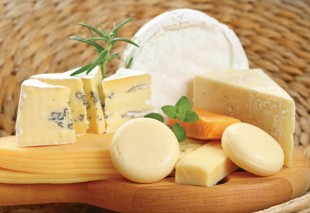

The delights of dairy

The growing health trend has not quashed consumer enthusiasm for dairy goods, but chefs and suppliers still face issues in their quest to further the dairy market
Be it milk, cream, butter or cheese, it is hard to get through the day without coming across some kind of dairy produce.
Such foodstuffs have been a staple part of our daily consumption over the centuries, and despite radically changing dietary patterns, the same is true today — as Mövenpick Resort Tala Bay Aqaba sous chef Rami Zain points out.
“We use dairy products in all our meals; our use probably exceeds 80% — they are a necessity,” he states.
Dubai Creek Golf and Yacht Club sous chef Neil Wilkinson agrees: “I would say about 50-60% of people in the Middle East consume dairy products at least once a day, maybe twice.”
Dairy suppliers can also vouch for the products’ success in this region.
Paddy Darcy, Middle East regional manager for Pritchitts — a Lakeland Dairies company and manufacturer of high quality, super-pasteurised long-life dairy and related goods — comments: “Dairy ingredients are extremely popular across the Middle East, with locally-sourced produce and European and southern hemisphere producers all competing in an extremely tough market.”
And “demand is growing across the GCC”, according to Classic Fine Foods Emirates general manager Thomas Leroy.
However one trend F&B professionals have flagged up recently is that of health awareness.
The region’s governments have become increasingly involved in promoting healthy eating, and now consumer spending is recovering after the financial downturn, health-conscious eating seems to be the next focal point for foodies.
But contrary to what may have been expected, given the fat content prevalent in many dairy items, this rising nutritional awareness is actually sustaining demand for such goods.
Mövenpick’s Zain asserts: “All dairy products contain calcium, which helps children grow and contains iron to build up the immune system.”
Dubai Creek’s Wilkinson adds that the health trend has not prompted any move away from dairy items, but more interest in how they are used. “We still use about 40% dairy items on our menus; but we incorporate these into a range of dishes, so customers have a choice of healthy options.”
But at same time, suppliers have seen the health trend taking off — and they claim executive chefs are being more careful with what dairy items they purchase as a result.
Pritchitts’ Darcy notes: “Executive chefs are moving towards products with lower fats, especially trans-fats. This reflects the fact that more and more restaurants are preparing healthy options.
“However it is fair to say this trend has not yet taken hold in the Middle East in the same way it has in other regions, such as Europe,” he adds.
Lactalis International overseas general manager Francois-Xavier Rougagnou agrees: “We have recently witnessed a great deal of ‘Eat Healthy’ awareness campaigns right across the Middle East, in which the main message is to cut down on your fat intake.
“As suppliers, it is our role to work with customer demands; so to satisfy this trend, President Brand introduced a light option, the ‘0% Fat’ line.
“This range has captured a decent share of regional sales, proving that consumers are becoming more concerned with the fat content of their dairy foodstuffs,” he observes.
The other key trend relates to the type of dairy chefs are purchasing, with an increased demand for unusual or regional-specific dairy goods, such as specialist cheeses or creams.
Noting that many dairy items have a short shelf-life, Mövenpick’s Zain says improved transport has helped this market along significantly, bringing many more unusual dairy items into the region.
Lactalis’ Rougagnou puts the increased demand for more exotic items down to the growing restaurant scene.
“As more international restaurants come into to the region, for example from France, we are receiving requests for specific types of products that are authentically from their country of origin,” he explains.
But chefs are still experiencing problems when it comes to fulfilling their dairy demands.
“Availability from suppliers is still an issue,” says Mövenpick’s Zain.
“We use a lot of dairy products in our cooking, and getting the items delivered on time is somehow a challenge despite the fact that it is all available in the market nowadays.”
Dubai Creek’s Wilkinson agrees, explaining: “The main problem area with regards to availability is imported cheese. You don’t know from one week to the next if you are going to receive it.
“The cost of the cheese itself can also fluctuate depending on timing and where it is imported from.”
Pritchitts’ Darcy agrees that “the main challenge for any exporter is ensuring the continuity of supply”.
“However we have excellent distribution partners in the GCC and they help to ensure that there is a continuous supply of all our products,” he asserts.
But other dairy suppliers are still encountering challenges in bringing goods to the Middle East.
Lactalis’ Rougagnou explains: “In the wide range of cheese that Lactalis produces, some are made out of raw milk — and there are countries in the GCC that do not allow import of such products, while other places will enforce tough regulations for getting the product into the market.
“So overall, these regualtory differences make importing such products a real challenge.”
Labelling can also be problematic, according to Classic Fine Foods’ Leroy.
“Production in any company must be stopped in order to produce UAE products,” he asserts. “This has a direct impact on price, availability and consistency.”
It seems that dairy products will continue to enjoy a strong standing in the Middle East — albeit in a lighter format, if the health trend really takes hold.
But before the market can advance and offer more diverse items, suppliers may want to see some of the ongoing import issues addressed.